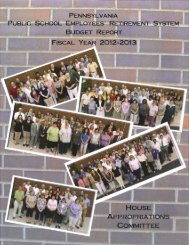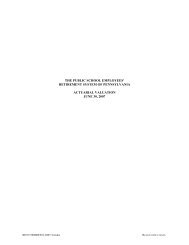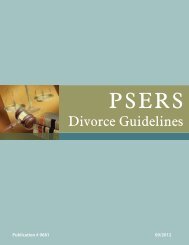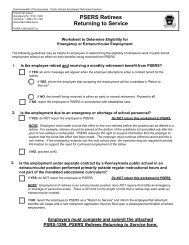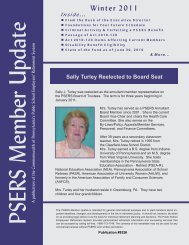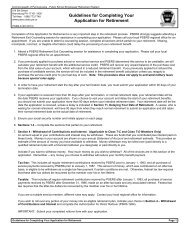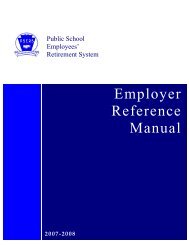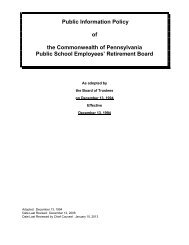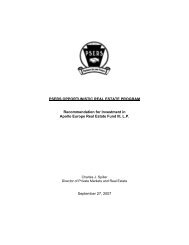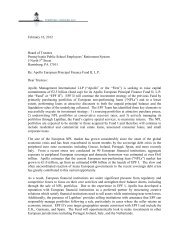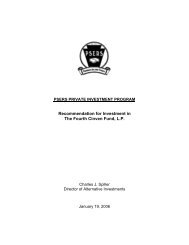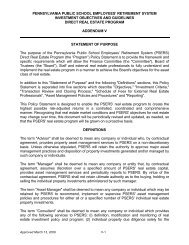a complete copy of the 2012 CAFR Report! - PSERs
a complete copy of the 2012 CAFR Report! - PSERs
a complete copy of the 2012 CAFR Report! - PSERs
You also want an ePaper? Increase the reach of your titles
YUMPU automatically turns print PDFs into web optimized ePapers that Google loves.
INTRODUCTORY SECTION<br />
Income from <strong>the</strong> investment portfolio represents <strong>the</strong> major source <strong>of</strong> revenue to <strong>the</strong> System, accounting for 71% <strong>of</strong><br />
total revenues over <strong>the</strong> twenty-year period from FY 1993 to FY <strong>2012</strong>. During FY <strong>2012</strong>, net investment income was<br />
$1.1 billion. The investment portfolio, which is one part <strong>of</strong> <strong>the</strong> System’s net assets, totaled $48.5 billion, at fair value,<br />
as <strong>of</strong> June 30, <strong>2012</strong>. For FY <strong>2012</strong>, <strong>the</strong> time-weighted rate <strong>of</strong> return on <strong>the</strong> System’s investments was 3.43%.<br />
The investment portfolio is well diversified to emphasize a long-term investment approach. The overall objective <strong>of</strong><br />
<strong>the</strong> System is to provide benefits to its members through a carefully planned and well-executed investment program.<br />
The return objectives are to (i) realize a return sufficient to achieve funding adequacy on an inflation-adjusted basis<br />
and that exceeds <strong>the</strong> Policy Index (<strong>the</strong> Policy Index is a custom benchmark, which is based on <strong>the</strong> Board-established<br />
asset allocation structure that seeks to generate a return that meets <strong>the</strong> actuarial rate <strong>of</strong> return assumption); and (ii)<br />
invest <strong>the</strong> assets to maximize returns for <strong>the</strong> level <strong>of</strong> risk taken. The risk objectives are to (i) diversify <strong>the</strong> assets <strong>of</strong><br />
<strong>the</strong> System to minimize <strong>the</strong> risk <strong>of</strong> losses within any one asset class, investment type, industry or sector distribution,<br />
maturity date, or geographic location; and (ii) invest <strong>the</strong> assets so that <strong>the</strong> probability <strong>of</strong> investment losses (as<br />
measured by <strong>the</strong> Policy Index) in excess <strong>of</strong> 15.0% in any one year is no greater than 2.5% (or two standard deviations<br />
below <strong>the</strong> expected return). Additional information on <strong>the</strong> System’s investments is contained in <strong>the</strong> Investment<br />
Section <strong>of</strong> this report.<br />
Federal and State Tax Status<br />
The System is a qualified trust fund under Section 401(a) <strong>of</strong> <strong>the</strong> Internal Revenue Code (IRC). As a result <strong>of</strong> <strong>the</strong><br />
qualified status, <strong>the</strong> trust fund is entitled to an exemption, under Section 501(a) <strong>of</strong> <strong>the</strong> IRC, from federal income<br />
taxation on its investment earnings. Additionally, contributions made on behalf <strong>of</strong> <strong>the</strong> active members are tax<br />
deferred under Section 414(h) <strong>of</strong> <strong>the</strong> IRC. The trust fund and any benefits accruing to <strong>the</strong> members <strong>of</strong> PSERS are<br />
exempt from Pennsylvania state and municipal taxes.<br />
It should be noted that <strong>the</strong> Internal Revenue Service (IRS) announced and initiated a renewed focus on <strong>the</strong> tax<br />
qualification <strong>of</strong> public pension funds in 2008. PSERS continues to work proactively, in conjunction with <strong>the</strong> State<br />
Employees’ Retirement System, to address this IRS initiative.<br />
Internal Controls and <strong>Report</strong>ing<br />
PSERS’ management is responsible for and has implemented internal controls designed to provide reasonable<br />
assurances for <strong>the</strong> safeguarding <strong>of</strong> assets and <strong>the</strong> reliability <strong>of</strong> financial records.<br />
This report has been prepared in accordance with accounting principles generally accepted in <strong>the</strong> United States <strong>of</strong><br />
America. The System maintains a full accrual accounting system. More specific accounting information is detailed<br />
in <strong>the</strong> Summary <strong>of</strong> Significant Accounting Policies (Note 2) in <strong>the</strong> notes to <strong>the</strong> financial statements found in <strong>the</strong><br />
Financial Section <strong>of</strong> this report.<br />
PSERS’ management believes <strong>the</strong> internal accounting controls currently in place are adequate to meet <strong>the</strong> purpose<br />
for which <strong>the</strong>y were intended and also believes <strong>the</strong> financial statements, supporting schedules and statistical tables<br />
are fairly presented.<br />
GASB Pension Accounting and Financial <strong>Report</strong>ing Project (Pension Project)<br />
In June <strong>2012</strong>, <strong>the</strong> Governmental Accounting Standards Board (GASB) approved a pair <strong>of</strong> related Statements that<br />
reflect substantial changes to <strong>the</strong> accounting and financial reporting <strong>of</strong> pensions by state and local governments and<br />
pension plans. Statement No. 67, Financial <strong>Report</strong>ing for Pension Plans, addresses financial reporting for state and<br />
local government pension plans. Statement No. 68, Accounting and Financial <strong>Report</strong>ing for Pensions, establishes<br />
new accounting and financial reporting requirements for governments that provide <strong>the</strong>ir employees with pensions.<br />
Statement No. 67 replaces <strong>the</strong> requirements <strong>of</strong> Statement No. 25, Financial <strong>Report</strong>ing for Defined Benefit Pension<br />
Plans and Note Disclosures for Defined Contribution Plans, for most public employee pension plans. Statement<br />
No. 68 replaces <strong>the</strong> requirements <strong>of</strong> Statement No. 27, Accounting for Pensions by State and Local Governmental<br />
Employers, for most government employers. The new Statements also replace <strong>the</strong> requirements <strong>of</strong> Statement No. 50,<br />
Pension Disclosures, for those governments and pension plans.<br />
PAGE 9



